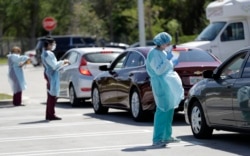The White House campaign-style video promoting President Donald Trump’s defense of his actions combating the emerging coronavirus threat earlier this year skips over his actions during the entire month of February, when he often downplayed concerns.
At the end of January, Trump imposed restrictions on travel from China where the virus first erupted. By mid-March, he declared a national emergency.
“This is a pandemic,” Trump said at a March 17 news conference. “I felt it was a pandemic long before it was called a pandemic.”
But in February, as the coronavirus threat grew across the world, and the first cases emerged in the United States, Trump belittled the threat.
Now, the president is trying to defend himself against news accounts showing that he was warned in February about the advance of the virus in the United States, even as he publicly dismissed concerns and said health officials had it under control.
Critics say February was a missed opportunity to move faster to recommend that Americans stay two meters away from other people, a position Trump adopted in mid-March and then extended through April. Later, he said Americans should consider wearing face masks in public, though he said he had no intention of wearing one.
The coronavirus death toll in the U.S. is now more than 23,000, with more than 582,000 confirmed cases. Both figures are more than in any other country, although this week officials say the number of new cases is leveling off, suggesting that the coronavirus threat may have reached a peak in the U.S.
Here are some of Trump’s comments in February about the coronavirus:
Feb. 10 at the White House: “Now, the virus that we’re talking about having to do — you know, a lot of people think that goes away in April with the heat — as the heat comes in. Typically, that will go away in April. We’re in great shape, though. We have 12 cases, 11 cases, and many of them are in good shape now.”
Feb. 23 to reporters: “We have it very much under control in this country.”
Feb. 24 on Twitter: “The Coronavirus is very much under control in the USA. We are in contact with everyone and all relevant countries. CDC & World Health have been working hard and very smart. Stock Market starting to look very good to me!”
Feb. 26 at the White House: “So, we’re at the low level. As they get better, we take them off the list, so that we’re going to be pretty soon at only five people. And we could be at just one or two people over the next short period of time. So, we’ve had very good luck.”
Feb. 26 at a news conference: “And again, when you have 15 people, and the 15 within a couple of days is going to be down to close to zero, that’s a pretty good job we’ve done.”
Feb. 27 at a White House meeting with African American leaders: “It’s going to disappear. One day — it’s like a miracle — it will disappear.”
Feb. 29 in a speech to conservatives: “And I’ve gotten to know these (health care) professionals. They’re incredible. And everything is under control. I mean, they’re very, very cool. They’ve done it, and they’ve done it well. Everything is really under control.”
In early March, ahead of his national emergency declaration in the middle of the month, Trump continued to downplay the threat to the U.S.
On March 9, he tweeted, “So last year 37,000 Americans died from the common Flu. It averages between 27,000 and 70,000 per year. Nothing is shut down, life & the economy go on. At this moment there are 546 confirmed cases of CoronaVirus, with 22 deaths. Think about that!”
A day later, he told Republican senators, “We’re prepared, and we’re doing a great job with it. And it will go away. Just stay calm. It will go away.”
At Monday evening’s news conference where the three-minute video highlighting his response to the coronavirus was played, Trump dismissed omission of his February comments and instead assailed CBS News reporter Paula Reid for asking about it.
“The month of February,” Reid said. “That video has a gap, the entire month of February. What did your administration do in February with the time that your travel ban bought you?”
“A lot,” Trump replied.
“What?” Reid asked.
“A lot,” Trump said. “And in fact, we’ll give you a list of what we did. And in fact, part of it was up there. We did a lot.”
“It wasn’t in the video,” Reid said. “The video had a gap.”
“Look. Look. You know you’re a fake,” Trump replied. “You know that? Your whole network, the way you cover it is fake.”
Trump’s reelection campaign later said that during February his administration moved to disperse testing kits to coronavirus hot spots in the country, cut red tape to start development of a vaccine, which may be a year away from development, and made its first emergency funding request to Congress.
As the emergency became apparent in the U.S., Trump on March 27 signed into law a $2 trillion coronavirus rescue package to send money to about 90% of Americans, aid 17 million laid-off workers and assist hard-hit businesses that have been severely affected by the pandemic.










